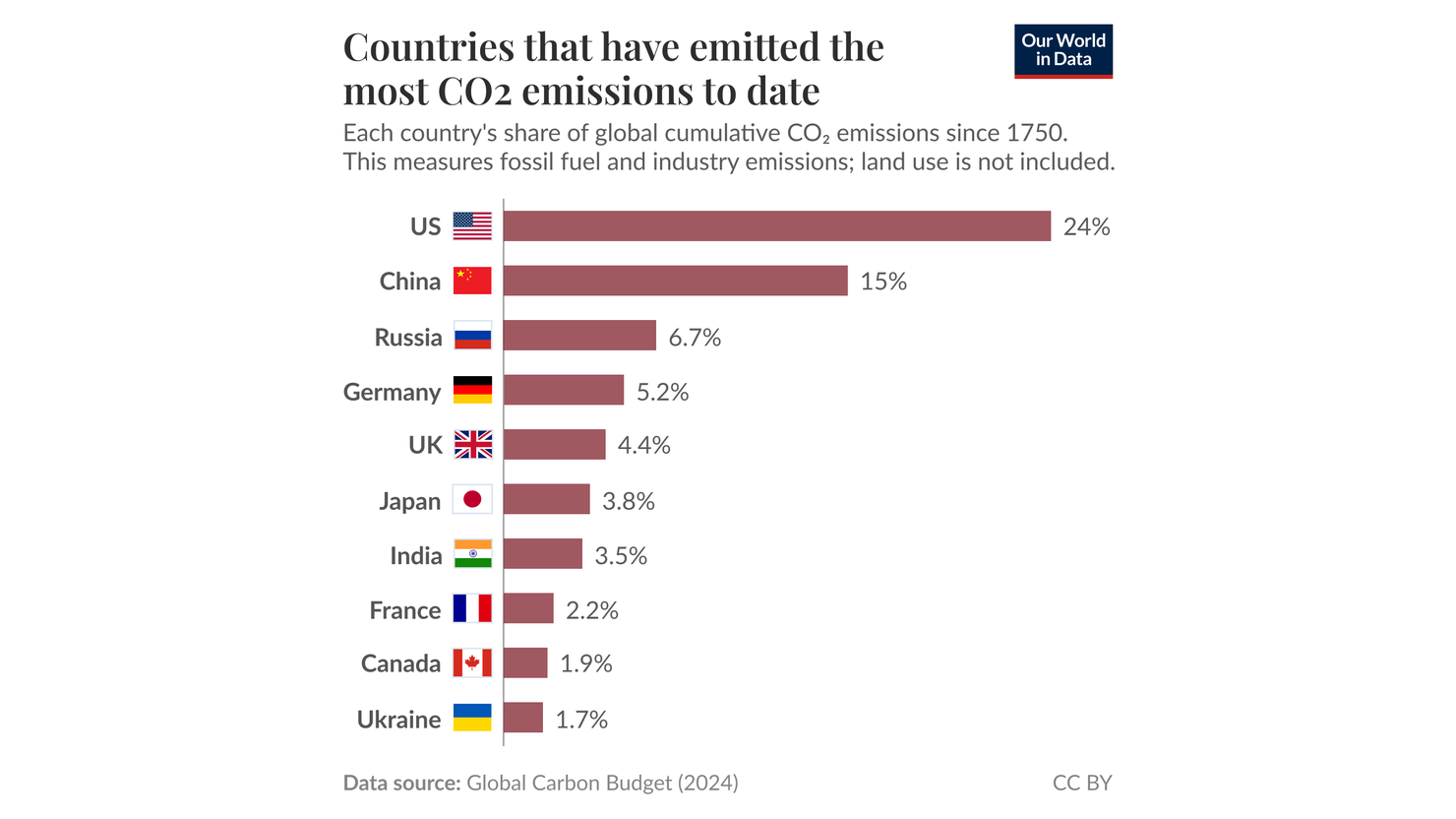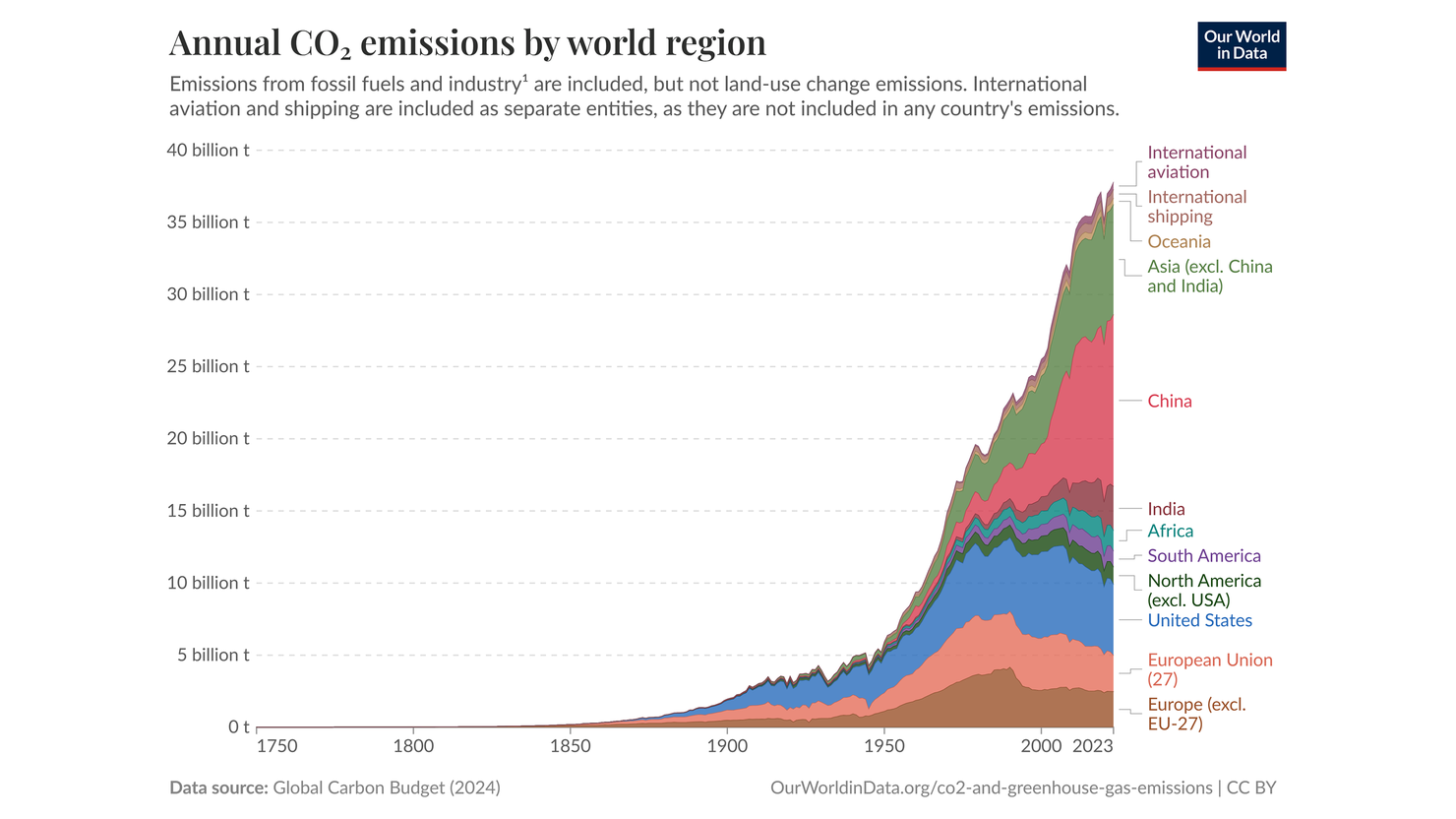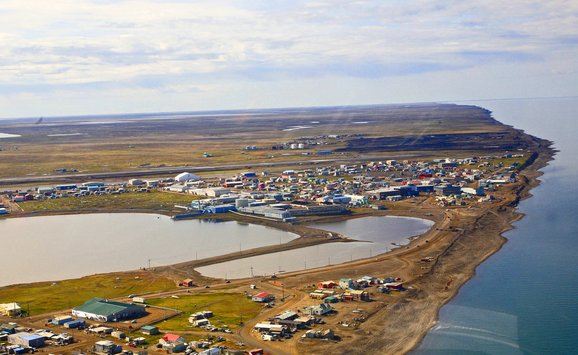
Twice a month, we’re compiling the most relevant news stories from diverse sources online, connecting the latest environmental and energy economics research to global current events, real-time public discourse, and policy decisions. Keep reading, and feel free to send us your feedback.
Here are some questions we’re asking and addressing with our research chops this week:
How does US climate policy impact global greenhouse gas emissions and climate commitments?
Last week, the US Environmental Protection Agency (EPA) proposed ending the Greenhouse Gas Reporting Program, which requires major industrial polluters to calculate and report their annual greenhouse gas emissions. The program was established in 2009 with the intention of collecting data on emissions from polluters to inform the creation of emissions regulations by EPA. In a new If/Then blog post, Resources for the Future (RFF) Fellow Milan Elkerbout points to two other recent actions by the current administration—the US withdrawal from the Paris Agreement and the proposed repeal of the endangerment finding—to highlight how both domestic and international US climate policy decisions can shape global emissions and climate impacts, with ripple effects felt worldwide. “No country truly stands or acts alone in global climate policy,” Elkerbout says. “The United States’ choice to reduce its own capabilities to take regulatory action and adopt stronger pledges under the Paris Agreement in the future might be very costly for itself and the rest of the world in the long run.”
How might a recent executive order reshape the way that federal agencies review energy regulations?
Last week, the US Senate Committee on Energy and Natural Resources advanced the nominations of David LaCerte, a senior advisor to the director of the US Office of Personnel Management, and Laura Swett, an attorney and former Federal Energy Regulatory Commission (FERC) staffer, to serve as FERC commissioners. Their nominations will now advance to the full Senate for approval. This anticipated shift in leadership comes as the agency faces potential changes to its process of policy review. An executive order issued in April directs FERC and other federal agencies to “sunset” many regulations—requiring that rules automatically expire after a defined date, unless specific action is taken to preserve them. Under this approach, regulations would be reevaluated before renewal, but those not explicitly preserved would terminate by default. In a recent If/Then blog post, RFF Visiting Fellow Todd Aagaard considers the legal and administrative implications of this approach to reevaluating policy, emphasizing the need for careful analysis to avoid significant regulatory disruptions. “If the agency continues to move forward carefully, FERC may avoid controversy and reduce its litigation risks,” says Aagaard.
With federal funding stalled, how can communities build their resilience in the face of increasing climate risks?
Extreme weather events are becoming more frequent and more intense with climate change, prompting renewed calls for infrastructure investments to strengthen disaster preparedness. Last week, flooding in Alaska led a borough just north of Anchorage to declare a disaster and request state assistance, while earlier in August, severe flooding in the city of Juneau caused extensive damage and highlighted the need for stronger flood protection. Such projects had been planned through EPA’s Community Change Grants Program, which was designed to fund infrastructure and workforce development initiatives—particularly those tied to climate resilience—across the country. But progress on those projects has stalled since the agency terminated the program in May. In a new If/Then blog post, RFF Senior Research Analyst Zach Whitlock and former RFF Research Associate Jordan Wingenroth outline what Community Change Grants were intended to achieve and how communities choose to invest in climate resilience, underscoring the long-term economic benefits of taking action. “If funding through the Environmental Protection Agency’s Community Change Grants Program is withheld, then communities across the country will miss out on a historic investment in basic infrastructure and workforce development,” say Whitlock and Wingenroth.

Expert Perspectives
Leasing Federal Lands for Development Would Jeopardize Conservation Gains
Last week, Secretary of the US Department of the Interior Doug Burgum proposed rescinding a public land management rule, finalized in April 2024, that enables public lands to be leased for conservation and restoration, similar to how such lands are leased for oil drilling. The rule also encourages the creation of additional “areas of critical environmental concern,” a designation that can limit development on lands that are important to wildfire conservation or that have historical and cultural significance. RFF Senior Fellow Margaret Walls and Senior Research Associate Alexandra Thompson have analyzed the potential consequences of public land sales for development, particularly in the context of proposals to sell public lands to purportedly help address the housing affordability crisis.
“The passage of the Federal Land Policy and Management Act in 1976 reflected a growing recognition of the value of public lands for conservation and recreation,” say Walls and Thompson in their recent Common Resources blog post. “Over time, through this resource-management process, presidential orders, and congressional action, many lands controlled by the Bureau of Land Management have been withdrawn from transfer or sale and protected as national monuments, national conservation areas, wilderness areas, and other types of conservation lands. In some cases, these sites eventually turn into national parks. Even unprotected Bureau of Land Management lands often have high value for recreation, serving as sites for off-highway vehicle use, dispersed camping, hunting, horseback riding, and more. These activities, in turn, drive the local outdoor-recreation economy and contribute to economic growth in Western rural communities. If federal lands are sold for private development, the lands become lost to those recreational uses, and options for protecting that value in the future are gone.”

Resources Roundup

Upcoming Event: Native Nations in the Energy Transition
For the past four years, researchers at RFF, the University of Arizona, Southern Methodist University, and other institutions have collaborated with the Southern Ute Indian Tribe on a research project aimed at supporting Tribal energy sovereignty. This in-person event (with virtual option for attendance) will showcase research results and explore additional topics related to Tribal energy sovereignty, the future of Tribal energy development, and how academic researchers can partner with Tribal nations to advance mutual interests. The event will include an opportunity for networking and relationship building. Register for the event.
Extreme Heat Negatively Impacts Student Behavioral Outcomes
On the Resources Radio podcast, Kristen McCormack, RFF’s newest research fellow, discusses the effects of extreme heat and lack of school air-conditioning on student behavior. McCormack’s work reveals that higher temperatures cause an increase in student absences and disciplinary infractions. She notes that the detrimental effect of hot temperature on disciplinary infractions is found only in schools without air-conditioning, suggesting that school air-conditioning may be protective for students. “Warming temperatures could cause more behavioral issues in schools, potentially exacerbating existing disparities in the school discipline system … We want our schools to provide a safe learning environment for all kids, and temperature is part of that,” McCormack says.
New Legislation Expands Clean Energy Tax Credits to Include Nuclear Energy Communities
The Inflation Reduction Act enables clean energy developers to receive a tax credit if they are located in communities where the economy is dominated by fossil fuel producers. Now, as a result of the recent budget reconciliation bill passed by Congress and subsequently signed by President Donald Trump on the Fourth of July, the Inflation Reduction Act has been updated to include nuclear energy communities—regions that have a certain percentage of employment tied to the development of nuclear energy. In a new In Focus video, RFF Fellow Daniel Raimi explores how these tax credits often exclude rural communities that are likely to harbor and depend on nuclear energy resources.
What’s the Role of Renewable Energy Credits in Financing Clean Energy Projects?
Renewable Energy Credits, or RECs, are clean energy credits that companies can purchase to meet their clean energy goals. However, RECs may be arguably effective in supporting clean energy projects. In a new blog post, RFF Fellow Aaron Bergman analyzes benefits and drawbacks of RECs. Currently, RECs are inexpensive and do not produce significant capital for clean energy projects. To derisk clean energy projects and help them secure better loans from banks, Bergman proposes long-term REC contracts with a fixed electricity price. “If the presence of RECs means more people are willing to enter into long-term contracts, basic economics suggests that there will be more long-term contracts,” Bergman says.
Government-Led Wildlife Conservation Can Revive Endangered Species Populations
The first US government–run environmental management agencies were essential to the rapid recovery of endangered populations, such as those of the white-tailed deer, after intense previous periods of population decline. On the Resources Radio podcast, Dominic Parker, a professor at the University of Wisconsin–Madison, discusses a recent journal article he coauthored about the economic, political, and social forces that have contributed to the creation and growth of state wildlife agencies. According to Parker, the “funding system is the main reason why game populations rebounded so well since agencies formed,” given that conservation efforts primarily have been financed with money collected from taxes applied to hunting and fishing.
State-Level Carbon Emissions Caps and Clean Energy Investments Would Be Effective at Promoting Energy Affordability
A projected rise in electricity demand and federal withdrawal from clean energy investments have created concerns about energy affordability for US households. In their new issue brief, RFF scholars Nicholas Roy and Dallas Burtraw examine the potential effects of a carbon price on the electricity sector in several US states. The results of their model demonstrate that state policy can shield households from the rising costs of electricity by implementing an emissions cap on carbon dioxide and investing in renewable energy—which also could help states reach their goals for reducing emissions.

#ChartOfTheWeek

Credits: Global Carbon Budget (2024), Hannah Ritchie / Our World in Data

Global Carbon Budget (2024), Hannah Ritchie and Max Roser / Our World in Data
Recently, federal regulations for carbon dioxide emissions have been under scrutiny by the federal government itself. As a leading contributor to global carbon dioxide emissions, the United States creates global impacts with its climate policy. The bar chart at the top illustrates the countries that have contributed most to cumulative global carbon dioxide emissions since the 1750s, with the United States the leading contributor. Similarly, the chart on the bottom depicts global annual carbon dioxide emissions, along with how much each region has contributed to the annual emissions total. The US contribution, shown third from the bottom in blue, consistently makes up a large portion of emissions. Its large historic and continued emissions ensure that the United States will have an impact on human health and global climate policy. But currently, EPA’s endangerment finding—which identifies the detrimental effects of carbon dioxide—is under scrutiny, which could shake things up for US climate policy in the near future. In a new blog post, RFF Fellow Milan Elkerbout addresses the impacts that repealing this finding could have on global carbon dioxide emissions.








